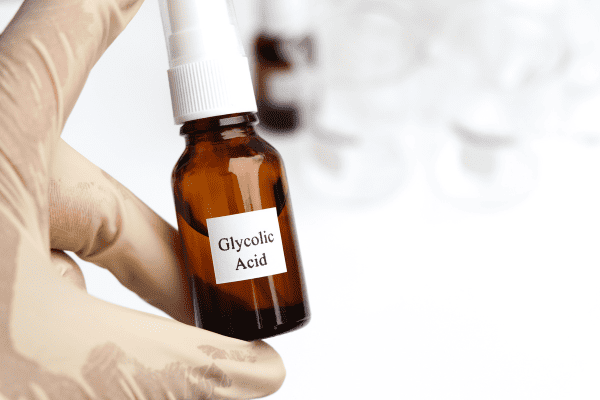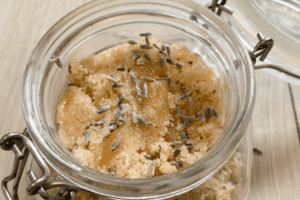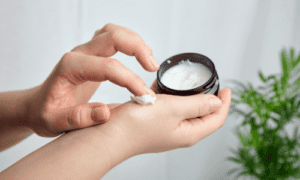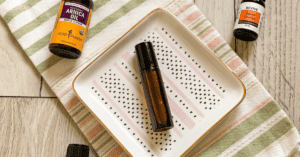Glycolic Acid Vs Salicylic Acid: Which is Better?
Discover the difference between glycolic acid and salicylic acid, and find out which is right for you!
Are you looking for more radiant, healthy skin? Have you heard that glycolic acid and salicylic acid will do the trick, but you aren’t sure which one you should use?
Glycolic and salicylic acids are both powerful chemical exfoliants that are said to work wonders on your skin. But they actually target different skin concerns and are suitable for different skin types.
Glycolic acid is an alpha hydroxy acid (AHA) that exfoliates the skin’s surface. It can even out an uneven skin tone, smooth out your skin’s texture, fade hyperpigmentation, and help the appearance of fine lines and wrinkles.
Pin this image for later!
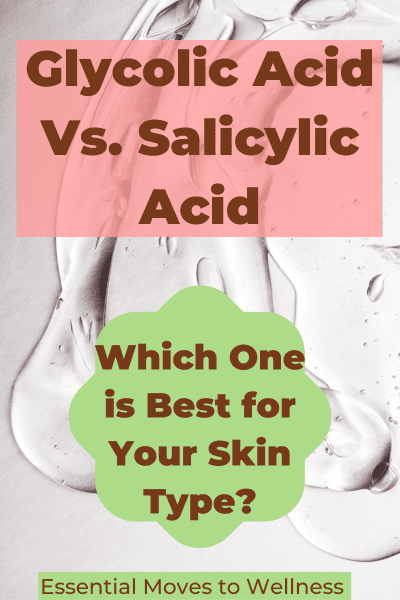
Salicylic acid, on the other hand, is a beta hydroxy acid (BHA), and it dissolves oil and treats acne and blackheads.
Alpha hydroxy acids, like glycolic acid, are great for improving skin tone and texture, while beta hydroxy acids are technically better at addressing oily skin and acne.
I am personally not a fan of salicylic acid, though, but more on that in a bit.
You might want to fully understand the risks and benefits of using each acid, before choosing the one that’s right for you.
If your skin looks dull and dry, or if you have mild hyperpigmentation, then glycolic acid might be your new best friend! But if your main concern is acne and clogged pores, then you’ve probably heard that salicylic acid is the answer.
And although I don’t want to disappoint you, it’s not quite as simple as that.
Let’s talk about glycolic acid vs salicylic acid. I’ll cover their benefits, the difference between the two, and why I’m not a fan of salicylic acid.
Of course, I’ll also show you how to choose the perfect acid for your unique skin type and throw in a few of my product recommendations as well!
This post contains affiliate links. You can learn more here.
What is Glycolic Acid and What Does It Do?
Glycolic acid is an alpha hydroxy acid, or AHA, derived from sugarcane, although it can also be made in a lab.
All alpha hydroxy acids are made from plants, and they are commonly found in skincare products. Other AHAs include lactic acid, citrus acid, malic acid, and tartaric acid.
Glycolic acid works by breaking down the bonds that hold dead skin cells together, and then gently sloughing that dead skin off. This makes room for new skin to grow. Which then gives you a healthy looking face!
Glycolic acid is an amazing little ingredient that has a ton of skincare benefits!
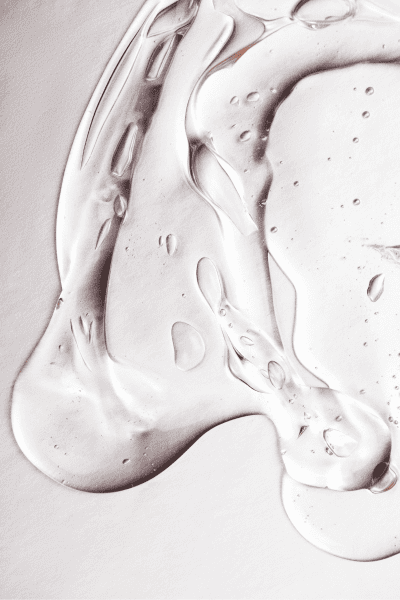
Glycolic acid:
- Exfoliates dead skin cells
- Promotes cell turnover
- Evens out uneven skin tone and texture
- Fixes hyperpigmentation
- Reduces the appearance of fine lines and wrinkles
- Repairs sun damage
- Fades acne scars
- Stimulates collagen production
- Reduces pore size
- Decreases inflammation
- Protects against UV B radiation
- Fights the bacteria that causes breakouts
- Brightens the complexion
- Increases skin firmness
- Increases the level of hyaluronic acid in your skin
And so much more!
Because of this, glycolic acid is a common ingredient in many moisturizers, serums, and tons of other skincare products.
But with great power comes great responsibility! Especially if you have sensitive skin.
Be careful when using glycolic acid. Start by using it slowly, maybe once a week. And then increase the use as your skin gets a little more used to the product.
And don’t forget the sunscreen! Sunscreen is so very important when adding glycolic acid into your skincare routine. This is because it can make your skin much more sensitive to the sun’s rays.
Here’s ten natural sunscreen products that can help protect your face, if you use glycolic acid.
What is Salicylic Acid and What Does It Do?
Salicylic acid is a beta hydroxy acid, or BHA, not an AHA. It is derived from willow bark and wintergreen leaves. Sounds nice, I know.
It, too, is very popular, and is often the main ingredient of prescription acne medications and some over-the-counter acne treatments. I was given one of these many years ago when I underwent that typical teenage acne phase.
It is some strong stuff. Salicylic acid has a higher acidity than glycolic acid. And while I remember getting a lot of irritation, I don’t remember it actually clearing up my skin that well!
BHAs also work by breaking down the bond that holds dead skin cells together, and then sloughing off that skin.
There are a few different BHAs, but only salicylic acid and related acids, such as salicylate and sodium salicylate, are used in the skincare industry. The others haven’t been studied as well, and they have a different chemical makeup than salicylic acid.
Salicylic acid is said to offer a ton of benefits for your skin, including:
- Dissolves oil
- Treats acne, blackheads, and oily skin
- Gives you a healthier looking complexion
- Removes excess sebum (oil) and reduces sebum production
- Fights wrinkles
- Lightens your skin
- Smoothes out your skin
Before you go all-in with salicylic acid, though, you should know that it can cause extreme redness, irritation, and sensitivity (which I can attest to).
Salicylic acid used to be a big part of my skincare routine, back before I started my clean beauty journey. I used a face wash that had salicylic acid in it every night.
And let me tell you, it was not pleasant. My face would always be burning and/or beat red. And my skin felt sooo tight and dry.
I know a lot of dermatologists recommend this stuff, but I don’t think it’s a one-size-fits-all acne solution. In fact, I am living proof that it is not! I also think this stuff made my skin overreact and produce even more oil as a result.
Although obviously biased, I personally think that your skin is better off without it. Especially for those who have sensitive skin.
Still, if you decide to use salicylic acid, here are some precautions to take:
- Always use sunscreen.
- Don’t use more than one product with salicylic acid in it.
- Stick to lower concentrations.
- Ask a doctor before using salicylic acid if you are pregnant or nursing.
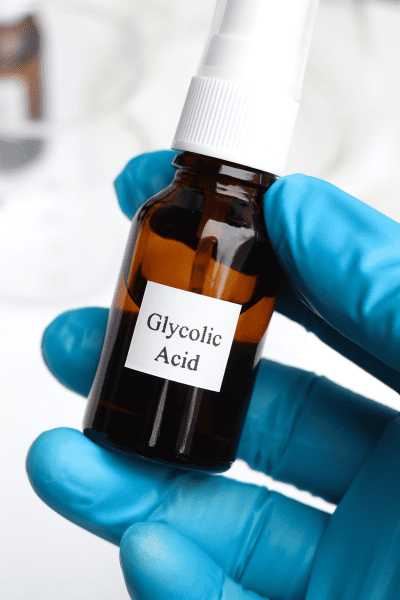
The Differences Between Glycolic and Salicylic Acid
While both glycolic and salicylic acids are chemical exfoliants, their molecular size, penetration levels, and suitability for different skin types set them apart.
Glycolic Acid
Glycolic acid is a water-soluble AHA, which means it works more on the skin’s surface. It doesn’t penetrate as deeply as an oil-soluble acid would.
This makes it less irritating and more suitable for dry, sensitive skin.
It’s also great at moisturizing the skin. Plus it stimulates the production of new skin cells, reducing the appearance of fine lines and wrinkles. This is why it is often found in anti-aging skincare products.
Glycolic acid is the go-to for dry, sensitive, or mature skin types that need hydration and anti-aging effects.
Salicylic Acid
Salicylic acid is an oil-soluble BHA that can penetrate deep into the pores and is used for oily or acne-prone skin. It breaks down any blockages and fights new breakouts.
It not only unclogs your pores, but it also controls acne by reducing the excess sebum production in oily skin.
But it is a harsher acid, so use it carefully. The benefits may not outweigh the risks. Overuse can lead to dryness, peeling, and irritation. And if you have sensitive skin, it’ll make your skin downright angry.
It just doesn’t work for everybody! It’s always best to start off using it sparingly, and to monitor your skin’s reaction closely.
Knowing the differences between these two acids can help you pick the most suitable acid for your skin’s needs. Also, it helps to understand your skin type and know what your skincare needs are, when shopping for any skin care products.
Whether you use glycolic acid or salicylic acid, you should always start out slowly, using just a little product at a time. If your skin likes it, slowly build up to using it more often.
How to Choose The Right Acid for Your Skin
Your skin type and skin needs should definitely be taken into account, when choosing the right acid for your skin.
If you have dry or sensitive skin, glycolic acid might be perfect for you! It has hydrating and anti-aging properties. And it, too, fights acne.
But if you have oily or acne-prone skin, salicylic acid is often recommended. But please keep in mind that it can – and does – cause severe allergic reactions.
Products That Contain Glycolic Acid or Salicylic Acid
There is a wide range of skincare products that contain glycolic acid or salicylic acid, each designed to address specific skin concerns and improve overall skin health.
You can find glycolic acid in toners, serums, masks, and cleansers.
GoopGlow 15% Glycolic Acid Overnight Glow Peel is perfect for those who want to try a chemical peel for the first time! My skin looked so bright and youthful the next morning, and I didn’t have any irritation at all.
And Josh Rosebrook Daily Acid Toner is great for those who want the best of both worlds! I like how it brightens my skin without having it feel stripped.
I personally can’t recommend using salicylic acid, just because of my own experience. But it might work for you. Who knows?
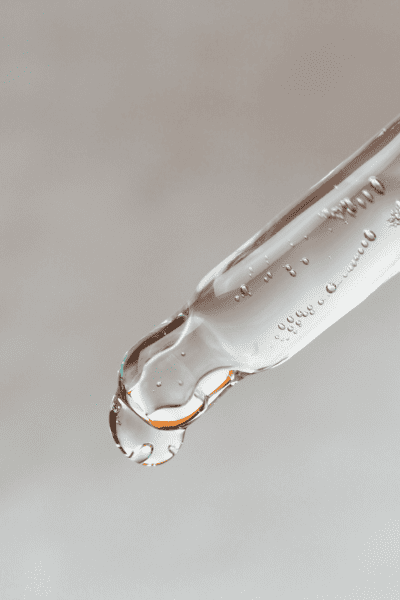
How to Add Glycolic and Salicylic Acid into Your Daily Routine
Using glycolic or salicylic acid in your skincare routine might seem daunting at first. But no worries!
Here are some tips to help you get started:
- Start by introducing acids slowly. Use them once or twice a week, and work up to every other night until you start seeing results.
- Be cautious when combining different exfoliating products. Using the two together may cause irritation and over-exfoliation.
- Never, ever use acids more than once a day!
And remember to always apply sunscreen when using these acids since they can increase your skin’s susceptibility to sun damage.
Frequently Asked Questions
Let’s tackle some common questions about glycolic and salicylic acids; their advantages, application, and appropriateness for various skin types.
We’ve covered a lot of ground so far, but you still may have some lingering questions.
And as always, if you don’t see the answers you need here, just leave your question in the comments below! I’m always happy to help.
What does glycolic acid do?
Glycolic acid is a powerful exfoliant that helps reveal brighter skin layers by breaking down the bonds between dead skin cells, while also fading unevenness or discoloration caused by sun damage, age spots, hyperpigmentation, and acne scars.
It comes from sugarcane and may also help boost collagen production and support skin moisture.
Glycolic Acid vs Salicylic Acid: Which is Better?
Glycolic acid, hands down!
Glycolic acid works wonders for hyperpigmentation and a lackluster complexion, while still helping with acne and breakouts.
Salicylic acid, while deemed best suited for breakouts and oily skin, is a really harsh chemical exfoliant that actually injures your skin to encourage the cell renewal process.
But ultimately, the best acid for you depends on your skin type and the results you’re looking for.
Can I Use Glycolic and Salicylic Acid Together?
I wouldn’t use glycolic and salicylic acid together. It will most likely cause irritation and over-exfoliation.
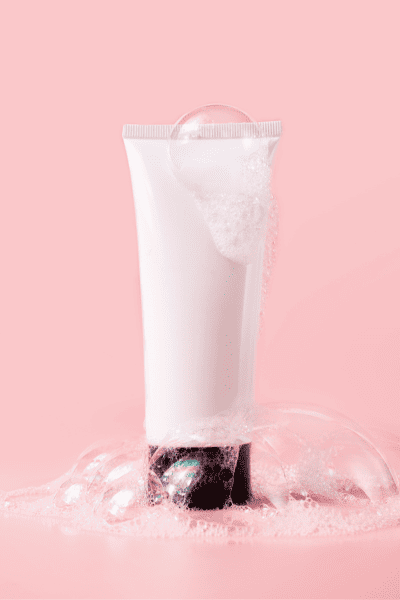
Should I Use Glycolic or Salicylic Acid at Night?
I would use both glycolic and salicylic acid at night, rather than in the morning. However, it’s still important to use sunscreen during the day, to protect your skin from sun damage. These acids make your skin more sensitive to the sun.
To avoid irritation, start with a lower concentration and gradually increase your use if your skin tolerates it well, and always follow up with a moisturizer and a sunscreen during the day.
Glycolic Acid vs Salicylic Acid: Which Is Better for Acne Prone Skin?
Salicylic acid is usually deemed the winner for acne-prone skin, thanks to its ability to remove excess dirt and sebum from deep within the pores. But… it literally damages your epidermis to get the job done.
I personally like more natural ways to care for my skin. That’s why I choose glycolic acid over salicylic acid. It’s way more gentle, and better for sensitive skin!
Glycolic Acid vs Salicylic Acid: Which is Better for a Chemical Peel?
I’d say glycolic acid is the best choice for a chemical peel. Especially if you are going to do it regularly .
Salicylic acid is often cited as the better choice for oily, combination, or acne-prone skin types. But I don’t recommend it.
What Skin Types is Salicylic Acid Best For?
Salicylic acid is said to be best for oily, combination, and acne-prone skin types because it can dissolve oil and clean out the pores. It also prevents new breakouts. That’s why so many people use it. And maybe you can too – if you have tough skin.
If you use salicylic acid, consider following up with a hyaluronic acid. It’ll replenish the moisture your skin lost and rehydrate your skin. I have a post all about it – Salicylic Acid and Hyaluronic Acid: Should You Use Both? (Spoiler alert: You shouldn’t!)
What Skin Type is Glycolic Acid Best For?
Glycolic acid is best for nearly everyone, in my humble opinion! But especially if you have dry, sensitive, or mature skin. It can improve your skin texture, reduce the appearance of wrinkles and fine lines, and promote cell turnover, for a more youthful glow.
What Acids Cannot Be Mixed in the Skin?
Glycolic acid and salicylic acid should not be mixed! Salicylic acid can cause irritation alone, but together, they can cause some serious damage, since they are both chemical exfoliants.
Before You Go…
There are so many bad ingredients in your skincare products that you may not even be aware of! It’s pretty scary, when you think about it.
These ingredients can cause things like cancer, reproductive toxicity, behavior problems, mood disorders, hormonal imbalance, and so much more. If you want to know more about which ingredients to avoid, and which may sound scary, but really aren’t, then check out my ebook!
Essential Moves to Clean Beauty will tell you everything you need to know, and walk you through switching out all of your toxic products for clean ones with no stress!
Grab your copy and start switching out all those harmful products today!
Related to Glycolic Acid vs Salicylic Acid
A Quick Guide to Starting a Natural Skin Care Routine for Beginners
Salicylic Acid and Hyaluronic Acid—Should You Use Both?
How to Start Your Clean Beauty Transition Without Losing Your Mind
5 Things No One Will Tell You About the Clean Beauty Movement (What to Expect)
Think Dirty App Review | Your Ingredient List Secret Weapon!

